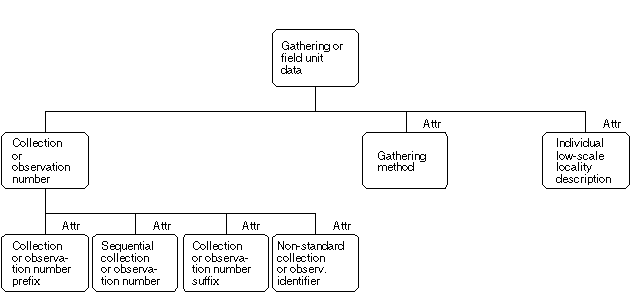
The entity subtype Gathering or Field Unit provides an interface to field oriented data which the collector or observer has considered to belong to a specific subset of data or materials accumulated in the gathering event. Several samples and/or observations may be made in a gathering event. In larger organisms, the gathering usually refers to a single individual or a cluster belonging to the same taxon. Yet in other organisms several taxa will be included, e.g. a piece of rock with several species of lichens, a water sample with microscopic algae, or a soil sample for microbiological investigation.
The possibility to directly refer to observations for which no voucher specimens were obtained can be used to record presence/absence data in floristic mapping projects. If materials are collected, the data of the gathering or field unit are characterized by being recorded before the object became part of a collection. However, as often collectors and curators are the same person, this delimitation is somewhat arbitrary. The gathering or field unit, together with the information connected to the gathering event and the field descriptor sets can best be viewed as the information contained in a collector's field book. In higher plants, the individual gathering is routinely identified by a field book number (the collection or observation number).
For parasites, data on the host or substrate are often recorded without actually sampling the substrate. In this case, parasite and substrate are separate gatherings of the same gathering event, which are associated (see under Association of Units).
Collections made within collections (e.g. herbarium collections from a botanical garden) are normally treated as derived unit creation events (see below). However, a new gathering results if the provenance of the first organism is irrelevant for the second one (e.g. the collection of a fungal parasite on a long cultivated plant in a greenhouse).
The following data items have been identified to be specific to gatherings or field units (Diagram 11):

Diagram 11: Data structure of the entity Gathering or Field Unit
The collection or observation number refers to the first collector's or observer's field book numbering. Standard practice (at least in higher plants) is to assign a single sequential number, but individual collectors may have preferences of their own. To accommodate any type of numbering, a prefix and a suffix is provided, as well as a field for different identifier schemes or for lot-identifiers as used in the sampling of micro-organisms. This also accommodates institutional series, which often consist of sequential numbers. However, in historic collections and collections of fungi, algae, or animals, this information may be incomplete or lacking. Curatorial additions to collection numbers (e.g. suffices assigned to the parts of a mixed specimen) are treated under derived unit data.
If collectors divide material between them, both assigning a collection number, two different gatherings for the same material are created. Such a relationship can be expressed by a unit association, too.
The gathering method is usually evident in higher plants, but in some cases notes may be taken (e.g. the drying temperature in the preparation of material destined for chemical analysis). In algae (e.g. "dredge from a boat"), micro-organism (e.g. "mixed soil sample from 1 square meter"), or zoological collections it is often a required data item. For presence/absence data, aerial photographs may be used and recorded as the method used to gather the information. As mentioned under Site Information, the attribute individual low-scale locality description allows a further specification of the individual collection site.